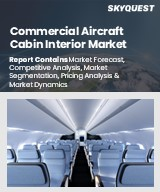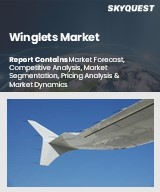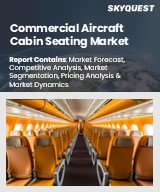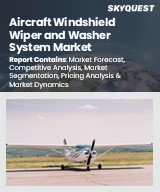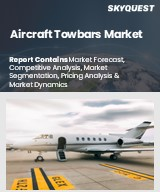
|
시장보고서
상품코드
1595719
민간 항공기 시장 : 세계 산업 분석, 규모, 점유율, 성장, 동향, 예측(2024-2033년)Commercial Aircraft Market: Global Industry Analysis, Size, Share, Growth, Trends, and Forecast, 2024-2033 |
||||||
주요 인사이트
- 민간 항공기 시장 규모(2024년) : 1,338억 3,000만 달러
- 시장 규모 예측(2033년) : 2,107억 9,000만 달러
- 세계의 시장 성장률(2024-2033년) : CAGR 5.2%
민간 항공기 시장의 수요는 항공 여행의 증가, 기술의 진보, 소비자 기대의 진화 등의 요인에 의해 크게 영향을 받습니다. 특히 신흥 시장에서의 항공 수요 증가는 항공기의 확장 및 현대화에 대한 투자를 촉진하여 항공기 제조업체와 관련 서비스 프로바이더에 큰 성장 기회를 제공합니다. 첨단 안전 기능을 갖춘 연료 효율적이고 친환경적인 항공기에 대한 수요는 시장을 형성하는 주요 동향입니다. 항공사는 항공기 설계 및 운영에서 지속가능성, 비용 효율성 및 기술 발전을 우선순위로 삼고 있습니다.
시장 성장 촉진요인
세계 민간 항공기 시장은 특히 아시아태평양의 가처분 소득 증가와 중산층 인구 증가에 따른 항공 여객 운송량 증가에 힘입어 강력한 성장세를 보이고 있습니다. 항공사들은 효율성 향상, 환경 규제 대응, 비용 절감을 위해 항공기를 현대화하고 있으며, 이는 첨단 연료 효율이 높은 항공기에 대한 수요를 창출하고 있습니다. 연료 효율이 높은 엔진, 경량 소재, 강화된 항공 전자공학 등의 기술 발전은 승객의 편안함과 운항 효율을 향상시켜 시장을 더욱 촉진하고 있습니다. 또한 신흥 국가 시장, 특히 중국과 인도의 공항 인프라 및 항공 교통 관리에 대한 막대한 투자도 항공 수요의 급증에 대응하기 위한 시장 확대를 지원하고 있습니다.
시장 기회
민간 항공기 시장은 아시아태평양 등 신흥 시장에서 수요 증가에 힘입어 견고한 성장 기회를 얻고 있습니다. 도시화, 중산층 증가, 경제 성장에 힘입어 항공기 제조 및 관련 공급망에 활력을 불어넣고 있기 때문입니다. 전기 항공기, 하이브리드 전기 항공기, 지속가능한 항공 연료(SAF)와 같은 기술 발전은 새로운 시장 개척의 길을 열어주고 있으며, AI와 머신러닝과 같은 혁신은 업무 효율성을 높이고 있습니다. 또한 환경 보호에 대한 관심은 친환경 및 저공해 항공기에 대한 수요를 촉진하고 있으며, 제조업체들은 첨단 추진 시스템 개발에 박차를 가하고 있습니다. 또한 항공기 구매보다 리스를 선호하는 추세가 강화되고 있으며, 이는 리스사의 사업 확장과 제조업체의 제조 증가 기회를 창출하고 있습니다.
세계의 민간 항공기 시장을 조사했으며, 시장의 정의와 개요, 시장 성장 촉진요인·억제요인, 각종 동향, 시장 기회, 과제, 시장 규모 추이·예측, 각종 구분·지역/주요 국가별 상세 분석, 경쟁 환경, 주요 기업의 개요 등을 정리하여 전해드립니다.
목차
제1장 개요
제2장 세계의 민간 항공기 : 시장 개요
- 시장 분류
- 시장 정의
- 시장 규모·예측
- 시장 역학
- 공급망
- 원재료 조달 전략
- 공급업체 리스트
- 평균 가격 분석
- 규칙
- 주요 참여 사업자 시장 입지(강도 맵) : 지역별
제3장 세계의 민간 항공기 시장 분석·예측 : 항공기 유형별
- 시장 규모·예측
- 협동체기
- 광동체기
- 리저널 제트
- 터보프롭기
제4장 세계의 민간 항공기 시장 분석·예측 : 지역별
- 시장 규모·예측
- 북미
- 라틴아메리카
- 유럽
- 일본
- 일본
- 중동 및 아프리카
제5장 북미의 민간 항공기 시장 분석·예측 : 국가별
제6장 라틴아메리카의 민간 항공기 시장 분석·예측 : 국가별
제7장 유럽의 민간 항공기 시장 분석·예측 : 국가별
제8장 일본의 민간 항공기 시장 분석·예측
제9장 일본을 제외한 아시아태평양의 민간 항공기 시장 분석·예측 : 국가별
제10장 중동 및 아프리카의 민간 항공기 시장 분석·예측 : 국가별
제11장 세계의 민간 항공기 시장의 기업 점유율·경쟁 구도·기업 개요
- 기업 점유율 분석
- 경쟁 구도
- 기업 개요
- The Boeing Co.
- Airbus SE
- Embraer SA
- Bombardier, Inc.
- Textron, Inc.
- Dassault Aviation SA
- General Dynamics Corporation
- Piaggio Aero Industries SpA
- Pilatus Aircraft Ltd.
- Avions de transport regional
제12장 조사 방법
제13장 2차 정보·1차 정보
제14장 가정·두자어
제15장 면책사항
KSA 24.12.02Persistence Market Research has recently released a comprehensive report on the global commercial aircraft market, offering detailed insights into the market dynamics, growth drivers, trends, opportunities, and challenges. The report examines the market structure and forecasts future developments, providing valuable data on the commercial aircraft industry.
Key Insights:
- Commercial Aircraft Market Size (2024E): USD 133.83 Bn
- Projected Market Value (2033F): USD 210.79 Bn
- Global Market Growth Rate (CAGR 2024 to 2033): 5.2%
Commercial Aircraft Market - Report Scope
The commercial aircraft market is an essential segment of the global transportation and aerospace industry. This market encompasses a wide range of aircraft designed for commercial passenger and cargo transport, including single-aisle, twin-aisle, regional jets, and freighters. The commercial aircraft market's demand is heavily influenced by factors such as air travel growth, advancements in technology, and evolving consumer expectations. The increasing demand for air travel, especially in emerging markets, is driving investments in the expansion and modernization of airline fleets, creating substantial growth opportunities for aircraft manufacturers and related service providers.The demand for fuel-efficient, environmentally friendly aircraft with advanced safety features is a key trend shaping the market. Airlines are increasingly prioritizing sustainability, cost-efficiency, and technological advancements in aircraft design and operations.
Market Growth Drivers
The global commercial aircraft market is witnessing robust growth, driven by rising air passenger traffic fueled by increasing disposable incomes and an expanding middle-class population, especially in Asia Pacific. Airlines are modernizing fleets to improve efficiency, comply with environmental regulations, and reduce costs, creating demand for advanced, fuel-efficient aircraft. Technological advancements, including fuel-efficient engines, lightweight materials, and enhanced avionics, are further boosting the market by offering improved passenger comfort and operational efficiency. Additionally, significant investments in airport infrastructure and air traffic management in developing regions, particularly in China and India, are supporting the market's expansion to meet the surge in air travel demand.
Market Restraints
The commercial aircraft market offers significant growth opportunities but faces notable challenges, including the high capital investment required for R&D, manufacturing, and maintenance, which creates barriers for new entrants and smaller manufacturers. Strict regulatory requirements on safety, emissions, and environmental impact further elevate production costs and can delay timelines. Additionally, the complex supply chain for critical components like engines and avionics is vulnerable to disruptions from geopolitical tensions, natural disasters, and pandemics, impacting production schedules. Volatile fuel prices add another layer of uncertainty, influencing airline pricing strategies and financial performance, which can ultimately affect demand for new aircraft.
Market Opportunities
The commercial aircraft market offers robust growth opportunities, driven by rising demand in emerging markets like Asia Pacific, fueled by urbanization, a growing middle class, and expanding economies, which boost aircraft production and related supply chains. Technological advancements, such as electric and hybrid-electric aircraft and sustainable aviation fuel (SAF), are unlocking new market avenues, while innovations like AI and machine learning enhance operational efficiency. Environmental sustainability initiatives are also driving demand for eco-friendly, low-emission aircraft, pushing manufacturers to develop advanced propulsion systems. Additionally, the increasing preference for aircraft leasing over outright purchases is creating opportunities for leasing companies to expand and for manufacturers to boost production volumes.
Key Questions Answered in the Report
- What are the key factors driving the growth of the commercial aircraft market globally?
- Which regions are leading the demand for commercial aircraft, and what factors are contributing to this growth?
- How are technological advancements influencing aircraft design and efficiency?
- Who are the leading players in the commercial aircraft market, and what strategies are they adopting to stay competitive?
- What are the future trends and opportunities for aircraft manufacturers and airlines?
Competitive Intelligence and Business Strategy
Leading players in the global commercial aircraft market, including Boeing, Airbus, and Embraer, focus on maintaining competitiveness through innovation, strategic partnerships, and production efficiency. These companies are investing heavily in research and development to produce next-generation aircraft that offer improved fuel efficiency, reduced environmental impact, and enhanced passenger comfort.
Key Companies Profiled
- The Boeing Co.
- Airbus SE
- Embraer SA
- Bombardier, Inc.
- Textron, Inc.
- Dassault Aviation SA
- General Dynamics Corporation
- Piaggio Aero Industries SpA
- Pilatus Aircraft Ltd.
- Avions de transport regional
- Others.
Commercial Aircraft Industry Segmentation
Aircraft Type
- Narrow body aircrafts
- Wide body aircrafts
- Regional jets
- Turboprop aircrafts
By Region:
- North America
- Latin America
- Europe
- Japan
- APEJ
- MEA
Table of Contents
1. Executive Summary
2. Global Commercial Aircrafts Market Overview
- 2.1. Introduction
- 2.1.1. Global Commercial Aircrafts Market Taxonomy
- 2.1.2. Global Commercial Aircrafts Market Definition
- 2.2. Global Commercial Aircrafts Market Size (US$ Bn) and Forecast, 2024-2033
- 2.2.1. Global Commercial Aircrafts Market Y-o-Y Growth
- 2.3. Global Commercial Aircrafts Market Dynamics
- 2.4. Supply Chain
- 2.5. Raw Material Sourcing Strategies
- 2.6. Supplier List
- 2.7. Average Pricing Analysis
- 2.8. Regulations
- 2.9. Key Participants Market Presence (Intensity Map) By Region
3. Global Commercial Aircrafts Market Analysis and Forecast By Aircraft Type
- 3.1. Global Commercial Aircrafts Market Size and Forecast By Aircraft Type, 2024-2033
- 3.1.1. Narrow body aircrafts Market Size and Forecast, 2024-2033
- 3.1.1.1. Revenue (US$ Bn) Comparison, By Region
- 3.1.1.2. Market Share Comparison, By Region
- 3.1.1.3. Y-o-Y growth Comparison, By Region
- 3.1.2. Wide body aircrafts Market Size and Forecast, 2024-2033
- 3.1.2.1. Revenue (US$ Bn) Comparison, By Region
- 3.1.2.2. Market Share Comparison, By Region
- 3.1.2.3. Y-o-Y growth Comparison, By Region
- 3.1.3. Regional jets Market Size and Forecast, 2024-2033
- 3.1.3.1. Revenue (US$ Bn) Comparison, By Region
- 3.1.3.2. Market Share Comparison, By Region
- 3.1.3.3. Y-o-Y growth Comparison, By Region
- 3.1.4. Turboprop aircrafts Market Size and Forecast, 2024-2033
- 3.1.4.1. Revenue (US$ Bn) Comparison, By Region
- 3.1.4.2. Market Share Comparison, By Region
- 3.1.4.3. Y-o-Y growth Comparison, By Region
- 3.1.1. Narrow body aircrafts Market Size and Forecast, 2024-2033
4. Global Commercial Aircrafts Market Analysis and Forecast By Region
- 4.1. Global Commercial Aircrafts Market Size and Forecast, 2024-2033
- 4.1.1. North America Commercial Aircrafts Market Size and Forecast, 2024-2033
- 4.1.1.1. Revenue (US$ Bn) Comparison, By Aircraft Type
- 4.1.2. Latin America Commercial Aircrafts Market Size and Forecast, 2024-2033
- 4.1.2.1. Revenue (US$ Bn) Comparison, By Aircraft Type
- 4.1.3. Europe Commercial Aircrafts Market Size and Forecast, 2024-2033
- 4.1.3.1. Revenue (US$ Bn) Comparison, By Aircraft Type
- 4.1.4. Japan Commercial Aircrafts Market Size and Forecast, 2024-2033
- 4.1.4.1. Revenue (US$ Bn) Comparison, By Aircraft Type
- 4.1.5. Japan Commercial Aircrafts Market Size and Forecast, 2024-2033
- 4.1.5.1. Revenue (US$ Bn) Comparison, By Aircraft Type
- 4.1.6. MEA Commercial Aircrafts Market Size and Forecast, 2024-2033
- 4.1.6.1. Revenue (US$ Bn) Comparison, By Aircraft Type
- 4.1.1. North America Commercial Aircrafts Market Size and Forecast, 2024-2033
5. North America Commercial Aircrafts Market Analysis and Forecast, By Country, 2024-2033
- 5.1. U.S. Commercial Aircrafts Market Size and Forecast, 2024-2033
- 5.1.1. Revenue (US$ Bn) Comparison, By Aircraft Type
- 5.2. Canada Commercial Aircrafts Market Size and Forecast, 2024-2033
- 5.2.1. Revenue (US$ Bn) Comparison, By Aircraft Type
6. Latin America Commercial Aircrafts Market Analysis and Forecast, By Country, 2024-2033
- 6.1. Commercial Aircrafts Market Size and Forecast, 2024-2033
- 6.1.1. Revenue (US$ Bn) Comparison, By Aircraft Type
- 6.2. Mexico Commercial Aircrafts Market Size and Forecast, 2024-2033
- 6.2.1. Revenue (US$ Bn) Comparison, By Aircraft Type
- 6.3. Argentina Commercial Aircrafts Market Size and Forecast, 2024-2033
- 6.3.1. Revenue (US$ Bn) Comparison, By Aircraft Type
7. Europe Commercial Aircrafts Market Analysis and Forecast, By Country, 2024-2033
- 7.1. Germany Commercial Aircrafts Market Size and Forecast, 2024-2033
- 7.1.1. Revenue (US$ Bn) Comparison, By Aircraft Type
- 7.2. France Commercial Aircrafts Market Size and Forecast, 2024-2033
- 7.2.1. Revenue (US$ Bn) Comparison, By Aircraft Type
- 7.3. U.K. Commercial Aircrafts Market Size and Forecast, 2024-2033
- 7.3.1. Revenue (US$ Bn) Comparison, By Aircraft Type
- 7.4. Italy Commercial Aircrafts Market Size and Forecast, 2024-2033
- 7.4.1. Revenue (US$ Bn) Comparison, By Aircraft Type
- 7.5. Spain Commercial Aircrafts Market Size and Forecast, 2024-2033
- 7.5.1. Revenue (US$ Bn) Comparison, By Aircraft Type
- 7.6. Spain Commercial Aircrafts Market Size and Forecast, 2024-2033
- 7.6.1. Revenue (US$ Bn) Comparison, By Aircraft Type
8. Japan Commercial Aircrafts Market Analysis and Forecast, By Country, 2024-2033
- 8.1. Russia Commercial Aircrafts Market Size and Forecast, 2024-2033
- 8.1.1. Revenue (US$ Bn) Comparison, By Aircraft Type
9. APEJ Commercial Aircrafts Market Analysis and Forecast, By Country, 2024-2033
- 9.1. China Commercial Aircrafts Market Size and Forecast, 2024-2033
- 9.1.1. Revenue (US$ Bn) Comparison, By Aircraft Type
- 9.2. India Commercial Aircrafts Market Size and Forecast, 2024-2033
- 9.2.1. Revenue (US$ Bn) Comparison, By Aircraft Type
- 9.3. ASEAN Commercial Aircrafts Market Size and Forecast, 2024-2033
- 9.3.1. Revenue (US$ Bn) Comparison, By Aircraft Type
- 9.4. Australia & NZ Commercial Aircrafts Market Size and Forecast, 2024-2033
- 9.4.1. Revenue (US$ Bn) Comparison, By Aircraft Type
- 9.5. South Korea Commercial Aircrafts Market Size and Forecast, 2024-2033
- 9.5.1. Revenue (US$ Bn) Comparison, By Aircraft Type
- 9.6. Taiwan Commercial Aircrafts Market Size and Forecast, 2024-2033
- 9.6.1. Revenue (US$ Bn) Comparison, By Aircraft Type
10. MEA Commercial Aircrafts Market Analysis and Forecast, By Country, 2024-2033
- 10.1. GCC Countries Commercial Aircrafts Market Size and Forecast, 2024-2033
- 10.1.1. Revenue (US$ Bn) Comparison, By Aircraft Type
- 10.2. Northern Africa Commercial Aircrafts Market Size and Forecast, 2024-2033
- 10.2.1. Revenue (US$ Bn) Comparison, By Aircraft Type
- 10.3. South Africa Commercial Aircrafts Market Size and Forecast, 2024-2033
- 10.3.1. Revenue (US$ Bn) Comparison, By Aircraft Type
- 10.4. Turkey Commercial Aircrafts Market Size and Forecast, 2024-2033
- 10.4.1. Revenue (US$ Bn) Comparison, By Aircraft Type
11. Global Commercial Aircrafts Market Company Share, Competition Landscape and Company Profiles
- 11.1. Company Share Analysis
- 11.2. Competition Landscape
- 11.3. Company Profiles
- 11.3.1. The Boeing Co.
- 11.3.2. Airbus SE
- 11.3.3. Embraer SA
- 11.3.4. Bombardier, Inc.
- 11.3.5. Textron, Inc.
- 11.3.6. Dassault Aviation SA
- 11.3.7. General Dynamics Corporation
- 11.3.8. Piaggio Aero Industries SpA
- 11.3.9. Pilatus Aircraft Ltd.
- 11.3.10. Avions de transport regional






